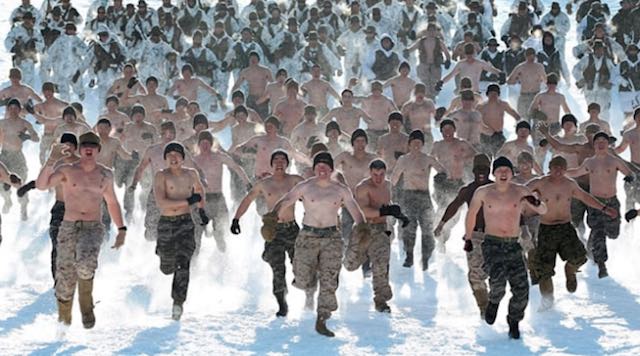Get the weekly SPARTANAT newsletter.
Your bonus: the free E-Book from SPARTANAT.

Military Fitness: Running in the cold?
Running in the cold? Torsten from MILITARY FITNESS asks this question today: Winter means laying the groundwork for many before the tougher running sessions begin. But should you actually go running in subzero temperatures? Or does it just make us unnecessarily sick?
I found different opinions on the internet. And all of them were written by some very important professor or sports scientist. The best sentence was: "Everyone reacts differently to cold."
Therefore, I would like to show you some facts and how I personally implement them as a long-time runner.
1. Breathe through your nose to avoid drying out your mucous membranes and filter out dirt and bacteria.
In theory, a good plan, but I can't get nearly as much air through my nose as I need for jogging (even during slow runs).
My tip: Breathe calmly through your mouth, but use a buff or thin scarf through which you can breathe.
2. Wear a hat or headband, as about 30 percent of heat is lost through the head.
Another blanket statement. Many say that this value of 30-40 percent is very outdated and only applies because the rest of the body is nicely bundled up.
During my time in the Bundeswehr, I also put on a hat at 10/15 degrees, because it was celebrated in training, I got used to it, and as a soldier, you constantly wear a head covering anyway. It took me several years to unlearn this, it was so ingrained.
My tip: Everyone has a different sensitivity to cold and should try out what works best for them personally. I run with very thin running hats that wick sweat to the outside.
3. After training, put on dry clothes immediately!
Absolutely yes!!! I can only leave it at that. If you don't train at home, it's better to stand outside for 30 seconds bare-chested in the cold and put on a dry shirt than to go home with wet clothes on your skin.
4. Wear moisture-wicking performance underwear – not cotton.
This probably refers to a performance top, as wearing long underwear under running pants doesn't make sense. Most running pants, especially winter running pants, already have this function integrated. Under no circumstances wear a cotton T-shirt, as it unnecessarily absorbs sweat and lies wet on the skin. (See also point No. 3.)
My tip: a performance top, and a proper running jacket over it. If it's too cold, you can wear a running T-shirt over the performance top. Some recommend a fleece jacket between the top and the jacket. Don't do that. Your body warms up unnecessarily. This slight overheating leads to a decrease in performance (especially beginners can find it very difficult to compensate).
In conclusion, I can only say that a few fundamental details should be considered, but ultimately everyone must figure out what works best for them.
I also recommend:
– Wear long pants, as you shouldn't unnecessarily expose your knees to the cold. (in the long run)
– Run at subzero temperatures with ease and with a consistent load (GA1), and move speed training indoors or postpone it.
– Protect your upper body, as this is where the important organs are.
Sporty greetings, Todde
SPARTANAT is the online magazine for Military News, Tactical Life, Gear & Reviews.
Send us your news: [email protected]
Ad
similar
Get the weekly SPARTANAT newsletter.
Your bonus: the free E-Book from SPARTANAT.


